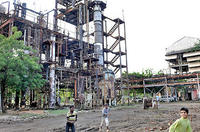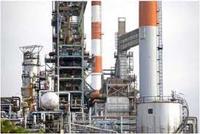-
West Virginia chemical spill degrades air, water quality
In the more than two months since the 9 January chemical spill into West Virginia’s Elk River, new findings reveal the nature of the chemicals that were released into the water and then into the air in residents’ houses. The lack of data motivated researchers to take on essential odor-related research that went beyond their National Science Foundation Rapid Response Research grant to better understand the properties of the chemical mixture called crude 4-methylcyclohexane methanol, the major component in the crude mix of the spilled chemicals into the Elk River
-
-
Debate over inherently safer technology (IST) at chemical plants intensifies

Recent accidents at chemical facilities around the country have prompt environmental groups and workplace safety advocates to highlight the need for implementing inherently safer technology (IST) at facilities using hazardous chemicals. IST is a methodology or an approach which calls for the adoption of a hierarchy of actions: minimize use of hazardous chemicals, substitute or replace hazardous chemicals with safer ones, moderate or shift to less hazardous chemicals or processes at lower temperatures and pressures, and simplify processes and design plants to eliminate unnecessary complexity.The industry argues that IST is a superficially simple concept but that, in reality, it is rather complex. For example, IST calls for facilities to reduce the amount of materials or chemicals they store on-site, which would increase transportation of the materials or chemicals, thus spreading the risk of chemical accidents to different points along the supply chain.
-
-
Determining long-term effects of West Virginia chemical spill
A chemical mixture called crude 4-methylcyclohexane methanol (MCHM) is used during the separation and cleaning of coal products. More than 10,000 gallons of the chemical leaked from a storage tank near Charleston, West Virginia, and entered the river upstream of a water-treatment plant on 9 January. The drinking water of more than 300,000 West Virginians was contaminated. Water restrictions began to be lifted on 13 January, but residents are still detecting the telltale odors of MCHM. Virginia Tech faculty engineers and students are unravelling fundamental chemical and health properties of MCHM.
-
-
“Encouraged” bacteria cleaning up more effectively after oil spills
Bioremediation is nature’s way of cleaning up. Plants, bacterial decomposers, or enzymes are used to remove contaminants and restore the balance of nature in the wake of pollution incidents. What is surprising is that given the right kind of encouragement, bacteria can be even more effective. Researchers in Norway have achieved surprising results by exploiting nature’s own ability to clean up after oil spills.
-
-
Not much is known about long-term health effects of chemical leaked in W.Va.
In January, 10,000 gallons an obscure chemical called 4-methylcyclohexanemethanol, or MCHM, used in processing coal, leaked from storage tanks into the nearby Elk River in the Charleston, West Virginia area, contaminating the water of more than 300,000 residents for days. To what degree MCHM affects long-term human and fetal health is a major concern for residents because of the lack of complete toxicology and other studies on the chemical.
-
-
W.Va. spill leads lawmakers, industry to look at reforming toxic substances law
The government was slow to respond to the 9 January 2014 massive chemical spill in West Virginia because the law governing such response, the 1976 Toxic Substances Control Act (TSCA), limits regulatory agencies’ authority to investigate such spills.Under TSCA, the EPA must first prove that a chemical poses an unreasonable risk to health or the environment before it can require the needed testing that would show a potential risk. One observer called this a Catch-22, telling a congressional panel that “This is like requiring a doctor to prove that a patient has cancer before being able to order a biopsy.”
-
-
ExxonMobil to pay fines for violations at its Baton Rouge chemical facilities
In a settlement with Louisiana’s Department of Environmental Quality (DEQ), ExxonMobil is ordered to pay $2.329 million to address violations from 2008 to 2013 at its greater Baton Rouge facilities. ExxonMobil was cited for a series of problems at its refinery and resin-finishing and chemical plants in East Baton Rouge Parish, and its tank-farm facility in West Baton Rouge.
-
-
Presidential commission releases chemical plants safety recommendations
There are 473 chemical facilities in the United States in which accidents would put 100,000 or more people at risk. In the aftermath of the May 2013 deadly explosion at a fertilizer plant in West, Texas, President Barack Obama established a working group to develop a list of potential changes to improve the industry’s risk management practices. Nearly two months past the end of October 2013 deadline, the group released their recommendations in early January.
-
-
Preventing a Bhopal-like catastrophe in New Jersey
New Jersey is home to ninety facilities which produce and store large quantities of highly toxic chemicals. A superstorm or terrorist attack could doom millions of people around southern New Jersey and eastern Pennsylvania to a Bhopal, 1984-like fate if either of these facilities and their storage tanks were affected.Typically, in the aftermath of major disasters, a blue ribbon panel is created to review preventative measures that could have been taken before the disaster. Security experts say that there is no need to wait for a post-disaster blue ribbon panel investigation to know what sensible safety measures should be implemented now.
-
-
Halt of CFATS work disrupts debate over program’s merit
The budget impasse-related halting of monitoring and enforcing compliance with the 2007 Chemical Facility Anti-Terrorism Standards (CFATS) comes at a time of growing criticism of the measure by GOP – but not only GOP – lawmakers, who complain that there are too many problems with CFATS and the way it has so far been implemented.
-
-
Furloughs hamper U.S. ability to respond to chemical disasters
Rafael Moure-Eraso, the chairman of the U.S. Chemical Safety Board(CSB) warned that the agency would be unable to respond to major chemical-related disasters if the government shutdown continued. The agency has furloughed more than 90 percent of its workers. The shutdown has delayed other CSB investigations into chemical accidents in California, Utah, Washington, and Texas. Moure-Eraso said that the delays in investigations could threaten public safety as the agency is unable to make recommendations for prevention of similar accidents.
-
-
Safety engineers welcome Obama’s chemical facility safety Executive Order
The American Society of Safety Engineers (ASSE) said it supports President Obama’s Executive Order to improve federal agency coordination of U.S. chemical facility safety and security oversight. The ASSE notes that while the causes of each chemical incident are unique and require careful investigation to help ensure similar incidents do not reoccur, common to every incident are the often overlapping and sometimes confusing layers of regulatory responsibility over facilities where potentially harmful chemicals are produced or stored.
-
-
Obama orders safety and security review of chemical plants
EPA data show there are 470 U.S. chemical facilities that put at least 100,000 people at risk in the event of a poison gas release. According to the American Chemistry Council, there are 13,796 chemical facilities in the country. The Fertilizer Institute counts about 6,000 fertilizer distributors around the country like the one that exploded 17 April. President Obama has ordered a government review of safety and security procedures at chemical plants in the United States.
-
-
Lawmakers, citing shortcomings, threaten funding for chemical plant safety program

Heads of three congressional panels urge DHS secretary Janet Napolitano to take to correct shortcomings in the Chemical Facilities Anti-Terrorism Standards (CFATS) program. “As the authorizers and appropriators of this program, we write to you to express serious reservations about continuing to extend CFATS funding without evidence of substantial programmatic improvement,” the three chairmen write in their letter to Napolitano. The lawmakers pointed to flaws in the program’s risk evaluation system, compliance hurdles, implementation delays, and the failure of the program to identify vulnerable facilities.
-
-
Texas to appeal FEMA decision not to declare West, Texas a disaster area
The Federal Emergency Management Agency (FEMA) said President Obama would not declare West, Texas a disaster area in the wake of the massive fertilizer plant explosion there two months ago, and Texas governor Rick Perry is not happy. FEMA said Texas did not make the case the state lacked funds for cleanup and recovery efforts.
-
- All
- Regional
- Water
- Biometrics
- Borders/Immig
- Business
- Cybersecurity
- Detection
- Disasters
- Government
- Infrastructure
- International
- Public health
- Public Safety
- Communication interoperabillity
- Emergency services
- Emergency medical services
- Fire
- First response
- IEDs
- Law Enforcement
- Law Enforcement Technology
- Military technology
- Nonlethal weapons
- Nuclear weapons
- Personal protection equipment
- Police
- Notification /alert systems
- Situational awareness
- Weapons systems
- Sci-Tech
- Sector Reports
- Surveillance
- Transportation
Advertising & Marketing: advertise@newswirepubs.com
Editorial: editor@newswirepubs.com
General: info@newswirepubs.com
2010-2011 © News Wire Publications, LLC News Wire Publications, LLC
220 Old Country Road | Suite 200 | Mineola | New York | 11501
Permissions and Policies
Editorial: editor@newswirepubs.com
General: info@newswirepubs.com
2010-2011 © News Wire Publications, LLC News Wire Publications, LLC
220 Old Country Road | Suite 200 | Mineola | New York | 11501
Permissions and Policies
